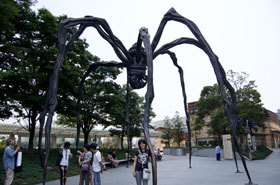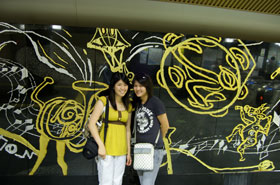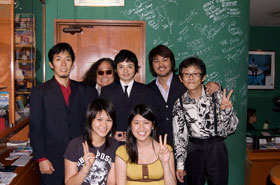Navigating Life in Another Country
Jade Kwan | July 13, 2009

Louise Bourgeois' Spider, a public art piece located in the neighborhood of Roppongi Hills.
I’m sure past and present PRIME students can agree that it wasn’t until the very moment they stepped foot in their host countries that it hit them: this summer would be special. Sure, it was easy to share with family and friends that I was going abroad for a summer internship. But with my stuffed backpack and my laptop at my side, I began my experience in Tokyo, Japan, with one word in mind: surreal.
The very first obstacle I faced was meeting up with Isabelle, the other PRIME student working at the National Institute for Information and Communications Technology (NICT). We were both at Narita International Airport without any technology to contact each other—no cell phones, no Blackberries. But we were able to meet by pure chance. We hurried to buy mobile phones, our first big purchase in Japan, and then we were on our way to experience the Japanese Railway.

Kwan and a fellow PRIME student pose in front of an art piece at the Roppongi train station.
We had to transfer onto two different railway lines and with our suitcases, it sure was an adventure. It also did not help that we were boarding at Shinjuku train station, the world’s busiest stop, during rush hour, when people were heading home from work. With my broken Japanese, we were able to make sure we were on the right line going in the right direction. (Shinjuku train station is the transfer point for about 15 different lines!)
When we finally got to Kokubunji (our stop about 30 minutes away), it was truly a relief. Not only were we able to regain some personal space once we stepped out of the train, but right outside of the station was someone from NICT waiting for us. He drove us to the institute and got our guest passes ready. I was instantly amazed with the large digital display showing Japan’s Standard Time on top of NICT’s main building. So I was not surprised when I learned that our guest passes were just as nifty: they served not only as our identification cards, but also as our access passes to the different buildings, laboratories and guest rooms. Oh, and did I forget to mention that we already had a meeting scheduled for the next morning?

A group photo with the band "The Parrots" that performs live Beatles music at the Abbey Road Live House located in Roppongi.
During our first meeting, we went over our plan for the week and soon got to meet professors, researchers, post-doctoral students and directors of the many different departments. Isabelle and I both work under the supervision of Dr. Shinji Shimojo, but as our projects differ, we often do not work in the same location. While she got to work in the Terahertz Project Laboratory stationed at NICT headquarters, I was assigned to travel to Otemachi, a district said to be similar to Wall Street in New York. My mentor, Dr. Shimojo, was able to show me the way on an early, rainy morning. But after that, I was on my own to make the 90-minute commute to Otemachi.
Along with taking note of what stops to get on and off at, I took note of some cultural differences. First off, although you are walking on a crosswalk, pedestrians cross the street as if they do not have the right of way. (I consciously remind myself to look right before looking left as drivers here drive on the left, just like in England!) Secondly, some Japanese buses require you to board at the back of the bus and leave from the front. In addition to improving the flow of passengers, I feel that this bus system allows people to not scramble for money when boarding the bus. Could this reflect a calmer spirit?

Different views of Tokyo.
Since I arrived here, I learned much about how a conversation about a person’s blood type can sometimes break the ice and how lunch hour can be very competitive—especially to get that affordable microwave meal from the convenience store. I was also very surprised to hear that NICT has a Music Club! It just goes to show how the institute’s environment is so diverse.
When lunch hour is over, work is very serious. People here sometimes do not leave until it gets dark. All of spring quarter, I — and the other 33 PRIME students — vigorously worked hard in preparation for our summer projects. On top of school and work, I spent four to five hours each week working on 3D modeling using a software program called Autodesk Maya. Within the Immersive Visualization Laboratory, under the supervision of Dr. Jürgen P. Schulze and in collaboration with Dr. Shimojo, we set up the goal of our project: take scientific datasets, manipulate them with 3D modeling and then provide digital interaction with the data onto high-definition tile display walls. As datasets are usually best understood by the researchers, we wanted to provide a visualization that both the researcher and general public can enjoy. To all those working in Japan: Ganbatte! (That’s Japanese for “courage!” or “hang in there!”)

|